Establishing a Hyperspectral Model for the Chlorophyll and Crude Protein Content in Alpine Meadows Using a Backward Feature Elimination Method
Abstract
:1. Introduction
- (i)
- To assess the effectiveness of PLS, RF, and tree-based regression methods in the quantification of Chl and CP levels.
- (ii)
- Testing the implementation of the BFE technique to optimize predictive models and determining the most important spectral parameters for predicting grassland quality markers based on their indicator importance and stability.
- (iii)
- To utilize partial least squares path modeling (PLS-PM) to explore both the direct and indirect linkages between the canopy structure and the soil background with spectral estimation of chlorophyll and crude protein contents and to explicate the network of relationships and intricate interactions that interlink these variables.
2. Materials and Methods
2.1. Study Area
2.2. Grassland Observation Data
2.2.1. Experimental Site Information
2.2.2. Indicators Measured in the Laboratory
- Forage chlorophyll (Chl) content: Spectrophotometry;
- crude protein (CP) content: Kjeldahl method.
2.3. Spectral Variables
2.4. Backward Feature Elimination
2.5. Partial Least Squares Regression
2.6. Random Forest Regression
2.7. Tree-Based Regression
2.8. Model Evaluation
2.9. Partial Least Squares Path Modeling
2.10. Technical Ideas
3. Results
3.1. Effects of Steppe Grassland Degradation on Plants’ Spectral Reflectance
3.2. Correlation Analysis
3.3. Regression Analysis Based on Backward Feature Elimination
3.4. Selection of Characteristic Variables
3.5. Partial Least Squares Path Modeling
4. Discussion
4.1. The Impact of Backward Feature Elimination on the Model’s Predictive Capability
4.2. Selection of Characteristic Variables
4.3. PLS-PM
5. Conclusions
- (i)
- PLS outperformed the RF in predicting Chl and CP in terms of the accuracy and certainty of its predictions.
- (ii)
- Backward feature elimination (BFE) can significantly decrease the number of spectral bands required for predictive analysis and simultaneously enhance the precision of the resulting models, particularly within the context of PLS regression techniques.
- (iii)
- Moreover, the spectral bands within the red edge and near-infrared regions proved to be significant and reliable in estimating the nutritional quality; particularly, the bands at 535 nm and 2091 nm are pivotal for the precise forecasting of CP, while vegetation indices such as the PRI and mNDVI are vital for predicting Chl.
- (iv)
- Environmental factors such as grassland cover (soil background) positively influence the prediction of SpecChl and SpecCP when degraded and non-degraded lands are interwoven. However, within the community structure, the evenness index negatively impacts the spectral predictions of both SpecChl and SpecCP. Notably, SpecChl has a robust positive correlation with the SpecCP estimation (r = 0.80), affirming that chlorophyll is indeed indicative of the photosynthetic nitrogen information associated with photosynthesis.
Author Contributions
Funding
Institutional Review Board Statement
Data Availability Statement
Conflicts of Interest
References
- Hopkins, A.; Holz, B. Grassland for agriculture and nature conservation: Production, quality and multi-functionality. Agron. Res. 2006, 4, 3–20. [Google Scholar]
- Kang, L. Grassland ecosystems in China: Review of current knowledge and research advancement. Philos. Trans. R. Soc. B Biol. Sci. 2007, 362, 997–1008. [Google Scholar] [CrossRef] [PubMed]
- Zhou, H.; Yang, X.; Hou, C.; Shao, X.; Shi, Z.; Li, H.; Su, H.; Qin, R.; Chang, T.; Hu, X.; et al. Alpine Grassland Degradation and Its Restoration in the Qinghai–Tibet Plateau. Grasses 2023, 2, 31–46. [Google Scholar] [CrossRef]
- Li, L.; Zhang, Y.; Wu, J.S.; Li, S.C.; Zhang, B.H.; Zu, J.X.; Zhang, H.M.; Ding, M.J.; Paudel, B. Increasing sensitivity of alpine grasslands to climate variability along an elevational gradient on the Qinghai-Tibet Plateau. Sci. Total Environ. 2019, 678, 21–29. [Google Scholar] [CrossRef] [PubMed]
- Li, X.L.; Gao, J.; Brierley, G.; Qiao, Y.M.; Zhang, J.; Yang, Y.W. Rangeland degradation on the Qinghai-Tibet plateau: Implications for rehabilitation. Land Degrad. Dev. 2013, 24, 72–80. [Google Scholar] [CrossRef]
- Li, X.; Perry, G.L.; Brierley, G.J. A spatial simulation model to assess controls upon grassland degradation on the Qinghai-Tibet Plateau, China. Appl. Geogr. 2018, 98, 166–176. [Google Scholar] [CrossRef]
- Xu, Y.; Dong, S.K.; Shen, H.; Xiao, J.N.; Li, S.; Gao, X.X.; Wu, S.N. Degradation significantly decreased the ecosystem multifunctionality of three alpine grasslands: Evidences from a large-scale survey on the Qinghai-Tibetan Plateau. J. Mt. Sci. 2021, 18, 357–366. [Google Scholar] [CrossRef]
- Ali, I.; Cawkwell, F.; Dwyer, E.; Barrett, B.; Green, S. Satellite remote sensing of grasslands: From observation to management. J. Plant Ecol. 2016, 9, 649–671. [Google Scholar] [CrossRef]
- Nagendra, H.; Lucas, R.; Honrado, P.; Jongman, R.; Tarantino, C.; Adamo, M.; Mairota, P. Remote sensing for conservation monitoring: Assessing protected areas, habitat extent, habitat condition, species diversity, and threats. Ecol. Indic. 2013, 33, 45–59. [Google Scholar] [CrossRef]
- Wang, Z.; Lucas, R.; Honrado, J.P.; Jongman, H.G.; Tarantino, C.; Adamo, M.; Mairota, P. Review of remote sensing applications in grassland monitoring. Remote Sens. 2022, 14, 2903. [Google Scholar] [CrossRef]
- El-Ramady, H.R.; Alshaal, A.T.; Amer, M.; Domokos-Szabolcsy, É.; Elhawat, N.; Prokisch, J.; Fári, M. Soil quality and plant nutrition. In Sustainable Agriculture Reviews 14: Agroecology and Global Change; Springer: Berlin, Germany, 2014; pp. 345–447. [Google Scholar]
- Zhu, S.; Feng, P.Z.; Feng, J.; Xu, J.; Wang, Z.M.; Xu, J.L.; Yuan, Z.H. The roles of starch and lipid in Chlorella sp. during cell recovery from nitrogen starvation. Bioresour. Technol. 2018, 247, 58–65. [Google Scholar] [CrossRef] [PubMed]
- Zhai, Y.; Cui, L.; Zhou, X.; Gao, Y.; Fei, T.; Gao, W. Estimation of nitrogen, phosphorus, and potassium contents in the leaves of different plants using laboratory-based visible and near-infrared reflectance spectroscopy: Comparison of partial least-square regression and support vector machine regression methods. Int. J. Remote Sens. 2013, 34, 2502–2518. [Google Scholar]
- Comino, F.; Ayora-Cañada, M.J.; Aranda, V.; Díaz, V.; Domínguez-Vidal, A. Near-infrared spectroscopy and X-ray fluorescence data fusion for olive leaf analysis and crop nutritional status determination. Talanta 2018, 188, 676–684. [Google Scholar] [CrossRef] [PubMed]
- Sishodia, R.P.; Ray, R.L.; Singh, S.K. Applications of remote sensing in precision agriculture: A review. Remote Sens. 2020, 12, 3136. [Google Scholar] [CrossRef]
- Inoue, Y. Satellite-and drone-based remote sensing of crops and soils for smart farming—A review. Soil Sci. Plant Nutr. 2020, 66, 798–810. [Google Scholar] [CrossRef]
- Zha, H.; Miao, Y.; Wang, T.; Li, Y.; Zhang, J.; Sun, W.; Feng, Z.; Kusnierek, K. Improving unmanned aerial vehicle remote sensing-based rice nitrogen nutrition index prediction with machine learning. Remote Sens. 2020, 12, 215. [Google Scholar] [CrossRef]
- Atzberger, C.; Guérif, M.; Baret, F.; Werner, Y. Comparative analysis of three chemometric techniques for the spectroradiometric assessment of canopy chlorophyll content in winter wheat. Comput. Electron. Agric. 2010, 73, 165–173. [Google Scholar] [CrossRef]
- Garnett, J. Using Infrared Spectroscopy to Evaluate Physiological Ageing in Stored Potatoes (Solanum tuberosum). Ph.D. Thesis, University of East Anglia, Norwich, UK, 2018. [Google Scholar]
- Li, L.; Lin, D.; Wang, J.; Yang, L.; Wang, Y. Multivariate analysis models based on full spectra range and effective wavelengths using different transformation techniques for rapid estimation of leaf nitrogen concentration in winter wheat. Front. Plant Sci. 2020, 11, 755. [Google Scholar] [CrossRef]
- Wang, W.; Yao, X.; Yao, X.F.; Tian, Y.; Liu, X.; Ni, J.; Cao, W.; Zhu, Y. Estimating leaf nitrogen concentration with three-band vegetation indices in rice and wheat. Field Crops Res. 2012, 129, 90–98. [Google Scholar] [CrossRef]
- Klem, K.; Rajsnerová, P.; Novotná, K.; Mìša, P.; Křen, J. Changes in vertical distribution of spectral reflectance within spring barley canopy as an indicator of nitrogen nutrition, canopy structure and yield parameters. Agriculture 2014, 60, 50–59. [Google Scholar] [CrossRef]
- Nussberger, S.; Dekker, J.; Kuehlbrandt, W.; Bolhuis, B.; Grondelle, R.; Amerongen, H. Spectroscopic characterization of three different monomeric forms of the main chlorophyll a/b binding protein from chloroplast membranes. Biochemistry 1994, 33, 14775–14783. [Google Scholar] [CrossRef] [PubMed]
- Gao, J.; Liang, T.; Yin, J.; Ge, J.; Feng, Q.; Wu, C.; Hou, M.; Liu, J. Estimation of alpine grassland forage nitrogen coupled with hyperspectral characteristics during different growth periods on the Tibetan Plateau. Remote Sens. 2019, 11, 2085. [Google Scholar] [CrossRef]
- Stroppiana, D.; Fava, F.; Boschetti, M.; Brivio, P.A. Estimation of nitrogen content in crops and pastures using hyperspectral vegetation indices. In Hyperspectral Remote Sensing of Vegetation; Thenkabail, P.S., Lyon, J.G., Huete, A., Eds.; Wiley Online Library: Hoboken, NJ, USA, 2011; pp. 245–262. [Google Scholar]
- Bioucas-Dias, J.M.; Plaza, A.; Camps-Valls, G.; Scheunders, P.; Nasrabadi, N.; Chanussot, J. Hyperspectral remote sensing data analysis and future challenges. IEEE Geosci. Remote Sens. Mag. 2013, 1, 6–36. [Google Scholar] [CrossRef]
- Landgrebe, D. Hyperspectral image data analysis. IEEE Signal Process. Mag. 2002, 19, 17–28. [Google Scholar] [CrossRef]
- Adjorlolo, C.; Cho, M.; Mutanga, O.; Ismail, R. Optimizing spectral resolutions for the classification of C 3 and C 4 grass species, using wavelengths of known absorption features. J. Appl. Remote Sens. 2012, 6, 063560. [Google Scholar] [CrossRef]
- Craig, A.P.; Franca, A.S.; Irudayaraj, J. Pattern recognition applied to spectroscopy: Conventional methods and future directions. In Pattern Recognition: Practices, Perspectives and Challenges; Vincent, D.B., Ed.; Nova Science Publishers, Inc.: New York, NY, USA, 2013; pp. 1–46. [Google Scholar]
- Fernández-Habas, J.; Cañada, M.; Moreno, A.; Leal-Murillo, J.; González-Dugo, M.; Oar, B.; Gómez-Giráldez, P.; Fernández-Rebollo, P. Estimating pasture quality of Mediterranean grasslands using hyperspectral narrow bands from field spectroscopy by Random Forest and PLS regressions. Comput. Electron. Agric. 2022, 192, 106614. [Google Scholar] [CrossRef]
- Tan, K.; Ma, W.; Wu, F.; Du, Q. Random forest–based estimation of heavy metal concentration in agricultural soils with hyperspectral sensor data. Environ. Monit. Assess. 2019, 191, 446. [Google Scholar] [CrossRef]
- Joshi, S.; Yi, S.; Jinniu, W.; Pasakhala, B.; Ismail, M.; Bisht, N.; Qamar, F.; Long, R.; Wu, N.; Foggin, M.; et al. Rangeland resource and use assessment protocol. Man. ICIMOD Kathmandu Rangel. Resour. Use Assess. Protoc. MANUAL 2019, 1, 3. [Google Scholar]
- Marabel, M.; Alvarez-Taboada, F. Spectroscopic determination of aboveground biomass in grasslands using spectral transformations, support vector machine and partial least squares regression. Sensors 2013, 13, 10027–10051. [Google Scholar] [CrossRef]
- Belgiu, M.; Drăguţ, L. Random forest in remote sensing: A review of applications and future directions. ISPRS J. Photogramm. Remote Sens. 2016, 114, 24–31. [Google Scholar] [CrossRef]
- Tuv, E.; Borisov, A.; Runger, G.; Torkkola, K. Feature selection with ensembles, artificial variables, and redundancy elimination. J. Mach. Learn. Res. 2009, 10, 1341–1366. [Google Scholar]
- Kotsiantis, S.B.; Zaharakis, L.D.; Pintelas, P.E. Machine learning: A review of classification and combining techniques. Artif. Intell. Rev. 2006, 26, 159–190. [Google Scholar] [CrossRef]
- Chen, J.M. Evaluation of vegetation indices and a modified simple ratio for boreal applications. Can. J. Remote Sens. 1996, 22, 229–242. [Google Scholar] [CrossRef]
- Jurgens, C. The modified normalized difference vegetation index (mNDVI) a new index to determine frost damages in agriculture based on Landsat TM data. Int. J. Remote Sens. 1997, 18, 3583–3594. [Google Scholar] [CrossRef]
- Wang, L.; Wei, Y. Revised normalized difference nitrogen index (NDNI) for estimating canopy nitrogen concentration in wetlands. Optik 2016, 127, 7676–7688. [Google Scholar] [CrossRef]
- Garbulsky, M.F.; Peñuelas, J.; Gamon, J.; Inoue, Y.; Filella, L. The photochemical reflectance index (PRI) and the remote sensing of leaf, canopy and ecosystem radiation use efficiencies: A review and meta-analysis. Remote Sens. Environ. 2011, 115, 281–297. [Google Scholar] [CrossRef]
- Sims, D.A.; Gamon, J.A. Relationships between leaf pigment content and spectral reflectance across a wide range of species, leaf structures and developmental stages. Remote Sens. Environ. 2002, 81, 337–354. [Google Scholar] [CrossRef]
- Jiang, Z.; Huete, A.; Chen, J.; Chen, Y.; Li, J.; Yan, G.; Zhang, X. Analysis of NDVI and scaled difference vegetation index retrievals of vegetation fraction. Remote Sens. Environ. 2006, 101, 366–378. [Google Scholar] [CrossRef]
- Gao, B.-C. NDWI—A normalized difference water index for remote sensing of vegetation liquid water from space. Remote Sens. Environ. 1996, 58, 257–266. [Google Scholar] [CrossRef]
- Mishra, S.; Mishra, D.R. Normalized difference chlorophyll index: A novel model for remote estimation of chlorophyll-a concentration in turbid productive waters. Remote Sens. Environ. 2012, 117, 394–406. [Google Scholar] [CrossRef]
- Huete, A.R. A soil-adjusted vegetation index (SAVI). Remote Sens. Environ. 1988, 25, 295–309. [Google Scholar] [CrossRef]
- Li, P.; Jiang, L.; Feng, Z.; Sheldon, S. Mapping rice cropping systems using Landsat-derived renormalized index of normalized difference vegetation index (RNDVI) in the Poyang lake region, China. Front. Earth Sci. 2016, 10, 303–314. [Google Scholar] [CrossRef]
- Schleicher, T.D.; Bausch, W.C.; Delgado, J.A.; Ayers, P.D. Evaluation and refinement of the nitrogen reflectance index (NRI) for site-specific fertilizer management. In Proceedings of the 2001 ASAE Annual Meeting, Anaheim, CA, USA, 18–21 August 1998. [Google Scholar]
- Blackburn, G.A. Hyperspectral remote sensing of plant pigments. J. Exp. Bot. 2007, 58, 855–867. [Google Scholar] [CrossRef]
- Mehmood, T.; Liland, K.; Snipen, L.; Sabo, S. A review of variable selection methods in partial least squares regression. Chemom. Intell. Lab. Syst. 2012, 118, 62–69. [Google Scholar] [CrossRef]
- Abdel-Rahman, E.M.; Mutanga, O.; Odindi, J.; Adam, E.; Odindo, A.; Ismail, R. A comparison of partial least squares (PLS) and sparse PLS regressions for predicting yield of Swiss chard grown under different irrigation water sources using hyperspectral data. Comput. Electron. Agric. 2014, 106, 11–19. [Google Scholar] [CrossRef]
- Svetnik, V.; Liaw, A.; Tong, C.; Culberson, J.C.; Sheridan, R.P.; Feuston, B.P. Random forest: A classification and regression tool for compound classification and QSAR modeling. J. Chem. Inf. Comput. Sci. 2003, 43, 1947–1958. [Google Scholar] [CrossRef] [PubMed]
- Liaw, A.; Wiener, M. Classification and regression by randomForest. R News 2002, 2, 18–22. [Google Scholar]
- Latan, H.; Noonan, R.; Matthews, L. Partial least squares path modeling. In Basic Concepts, Methodological Issues and Applications; Springer International Publishing AG: Berlin/Heidelberg, Germany, 2017. [Google Scholar]
- McIntosh, C.N.; Edwards, J.R.; Antonakis, J. Reflections on partial least squares path modeling. Organ. Res. Methods 2014, 17, 210–251. [Google Scholar] [CrossRef]
- Wijesingha, J.; Astor, T.; Schulze-Brüninghoff, D.; Wengert, M.; Wachendorf, M. Predicting forage quality of grasslands using UAV-borne imaging spectroscopy. Remote Sens. 2020, 12, 126. [Google Scholar] [CrossRef]
- Curran, P.J. Remote sensing of foliar chemistry. Remote Sens. Environ. 1989, 30, 271–278. [Google Scholar] [CrossRef]
- Kattenborn, T.; Eichel, J.; Fassnacht, F.E. Convolutional Neural Networks enable efficient, accurate and fine-grained segmentation of plant species and communities from high-resolution UAV imagery. Sci. Rep. 2019, 9, 17656. [Google Scholar] [CrossRef] [PubMed]
- Pullanagari, R.; Dehghan-Shoar, M.; Yule, L.J.; Bhatia, N. Field spectroscopy of canopy nitrogen concentration in temperate grasslands using a convolutional neural network. Remote Sens. Environ. 2021, 257, 112353. [Google Scholar] [CrossRef]
- Gamon, J.A.; Field, C.B.; Fredeen, A.L.; Thayer, S. Assessing photosynthetic downregulation in sunflower stands with an optically-based model. Photosynth. Res. 2001, 67, 113–125. [Google Scholar] [CrossRef]
- Adjorlolo, C.; Mutanga, O.; Cho, M.A. Predicting C3 and C4 grass nutrient variability using in situ canopy reflectance and partial least squares regression. Int. J. Remote Sens. 2015, 36, 1743–1761. [Google Scholar] [CrossRef]
- Kokaly, R.F. View_SPECPR, Software for Plotting Spectra (Installation Manual and User’s Guide, Version 1.2); US Geological Survey: Reston, Virginia, 2008.
- Chapin, F.S.; Bloom, A.J.; Field, C.B.; Waring, R.H. Plant responses to multiple environmental factors. Bioscience 1987, 37, 49–57. [Google Scholar] [CrossRef]
- Bélanger, G.; Gastal, F.; Lemaire, G. Growth analysis of a tall fescue sward fertilized with different rates of nitrogen. Crop Sci. 1992, 32, 1371–1376. [Google Scholar] [CrossRef]
- Funk, J.L.; Glenwinkel, L.A.; Sack, L. Differential allocation to photosynthetic and non-photosynthetic nitrogen fractions among native and invasive species. PLoS ONE 2013, 8, e64502. [Google Scholar] [CrossRef]

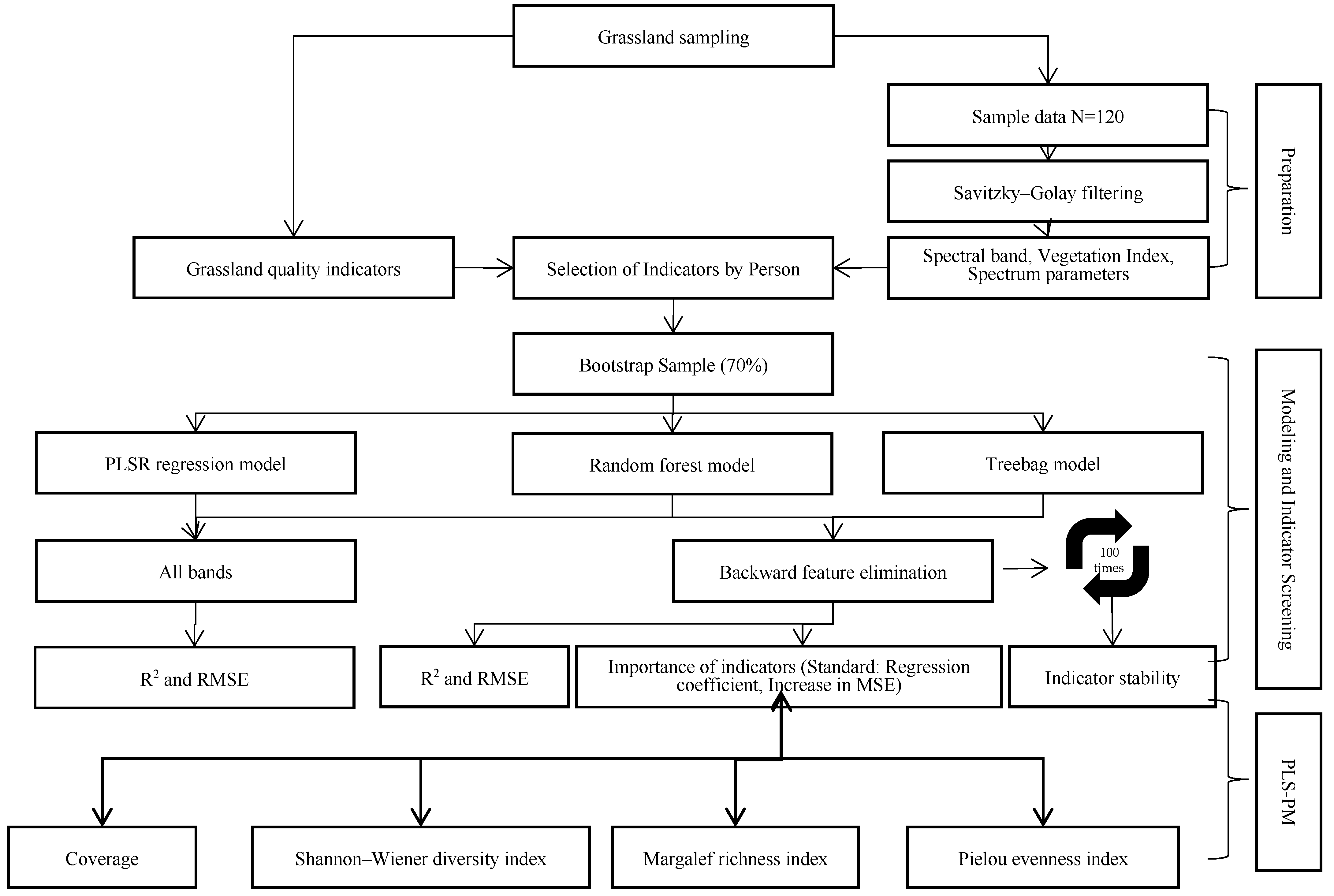

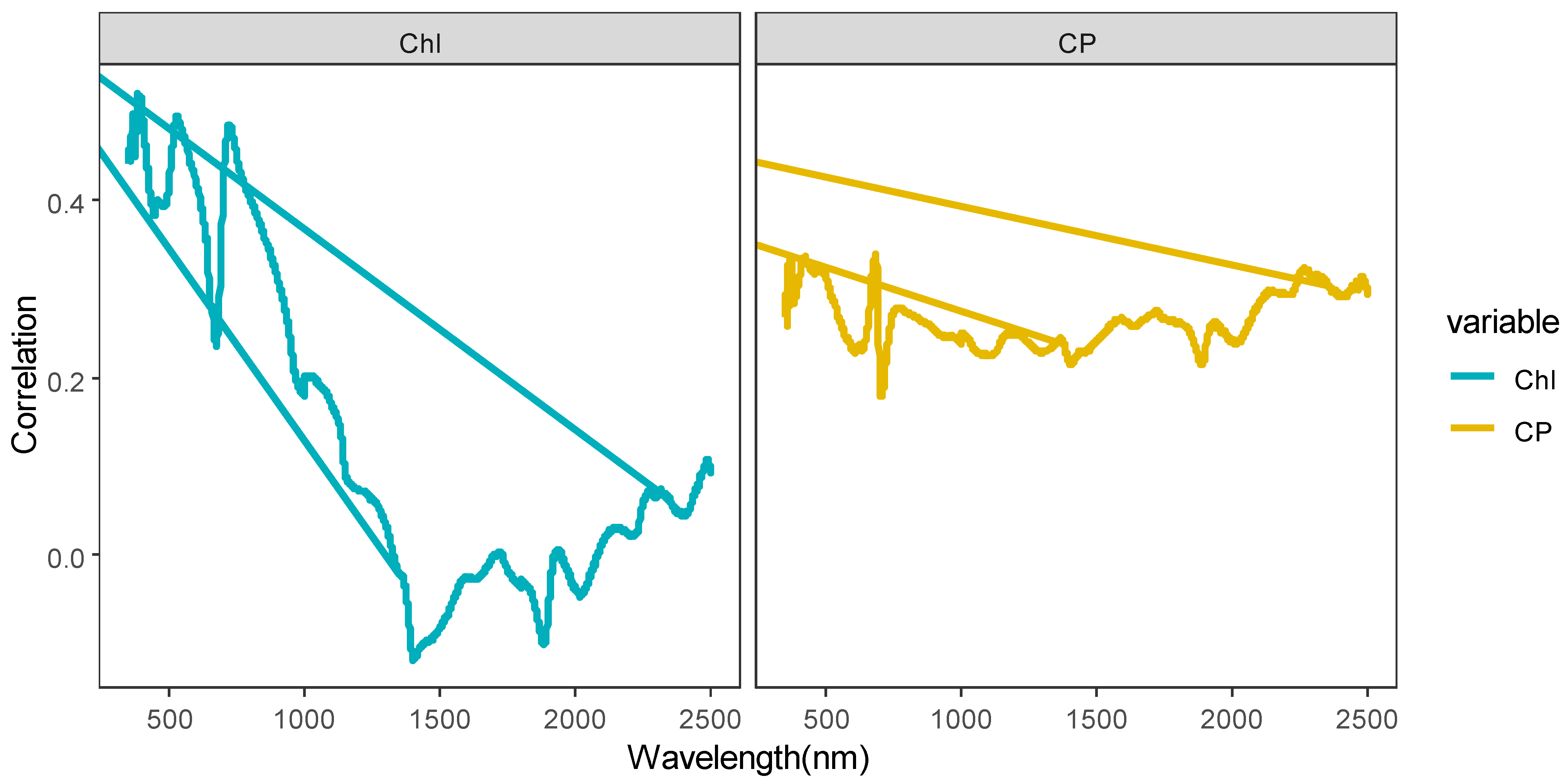
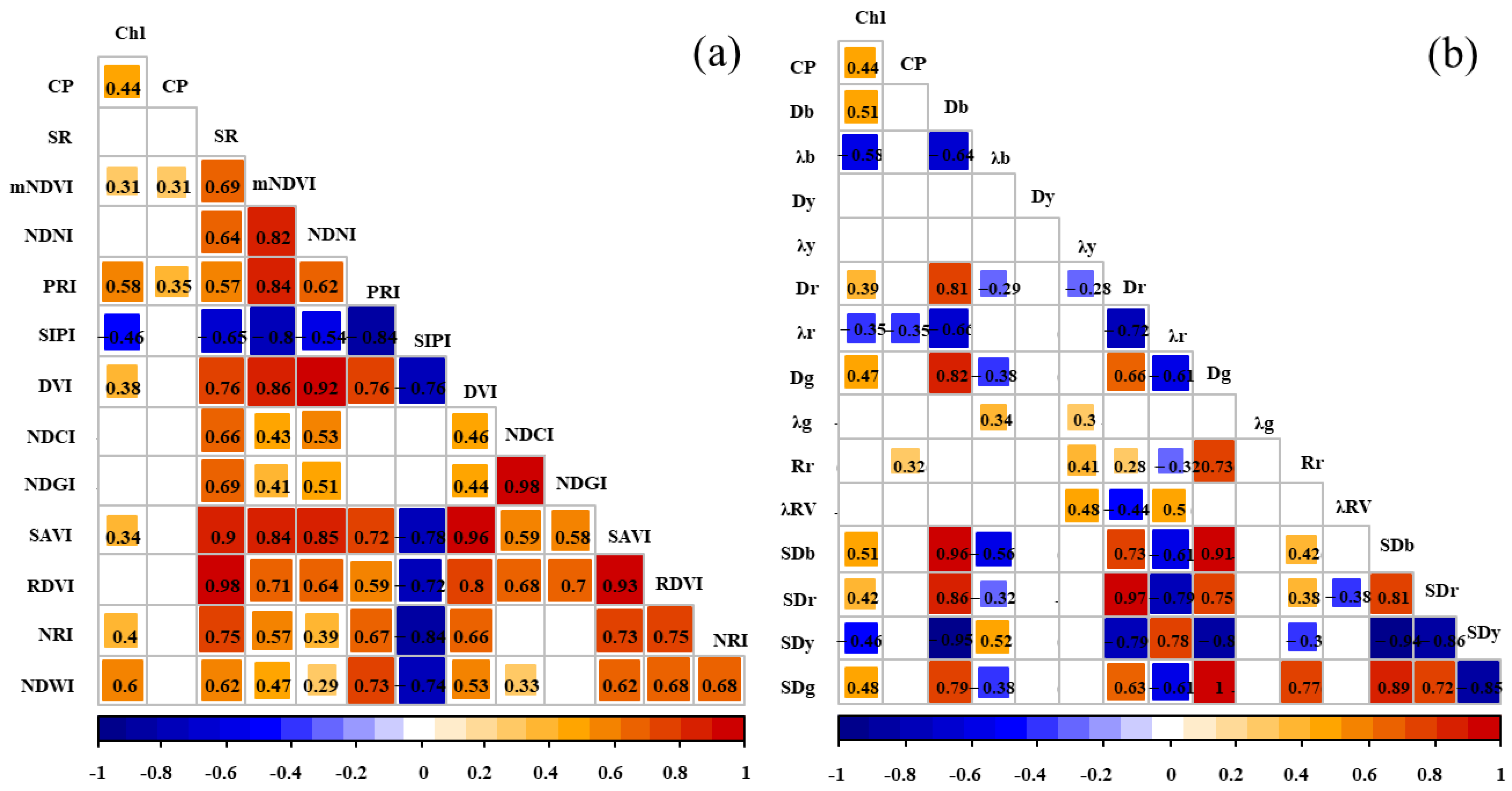

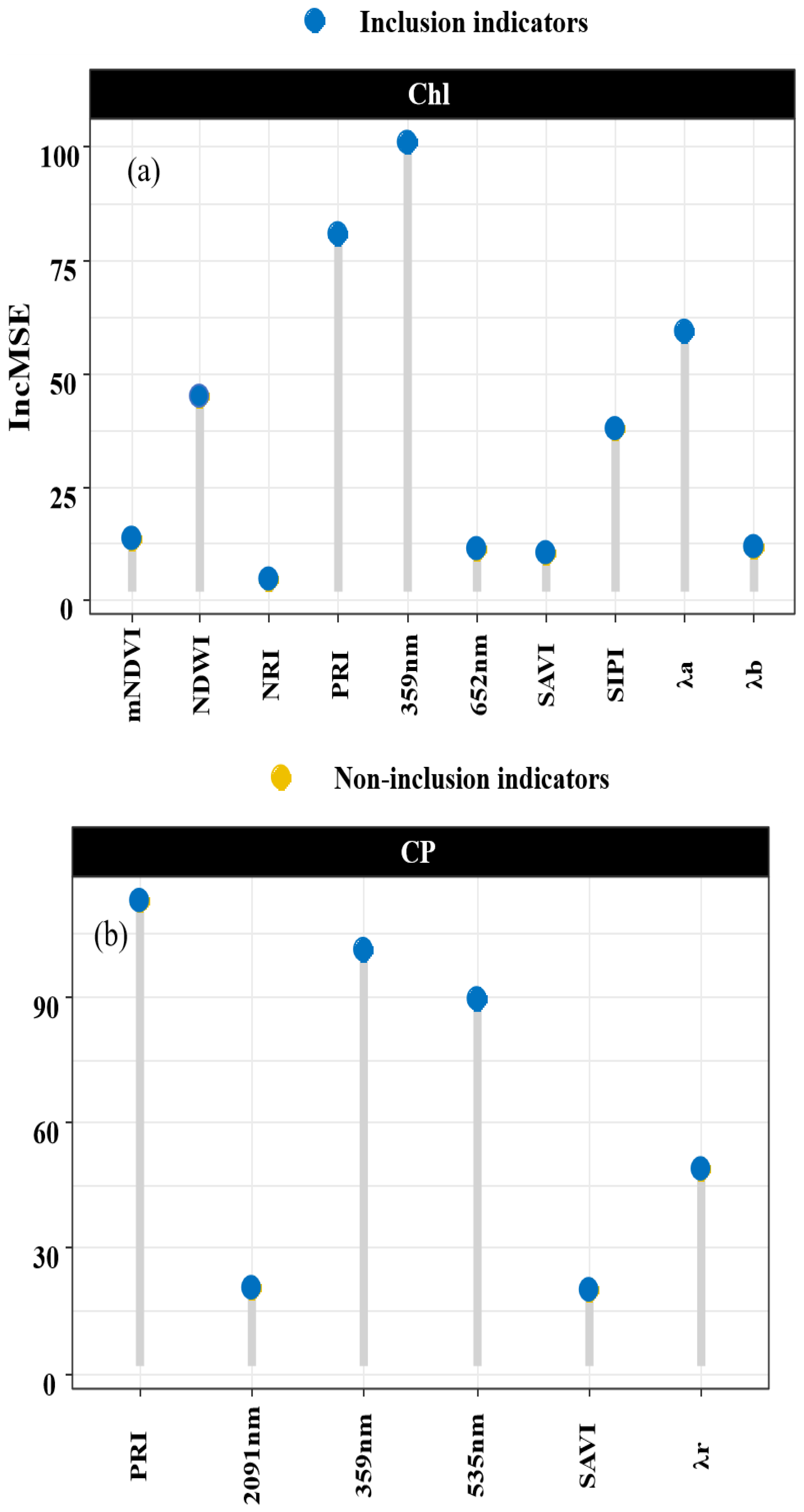
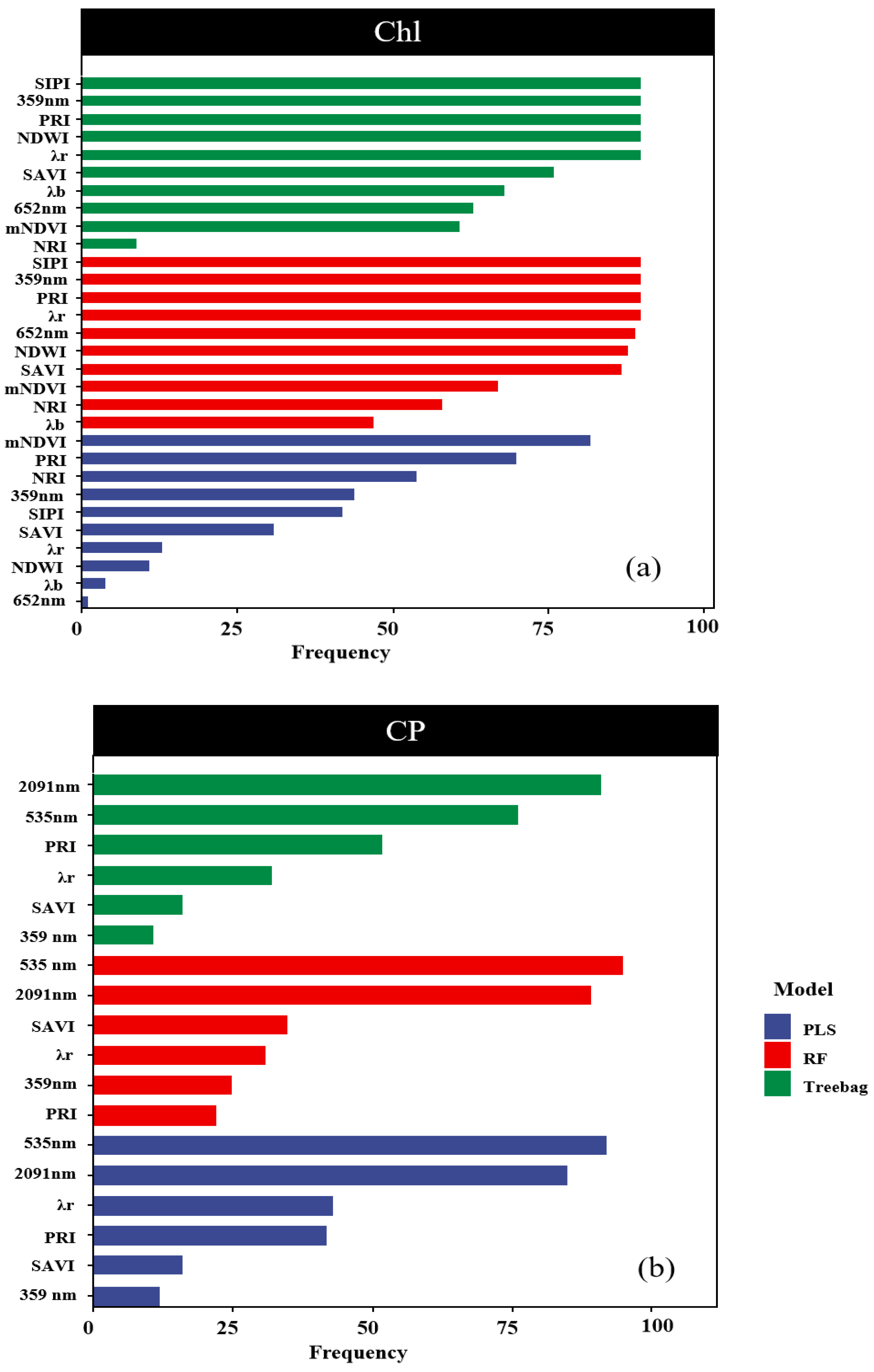
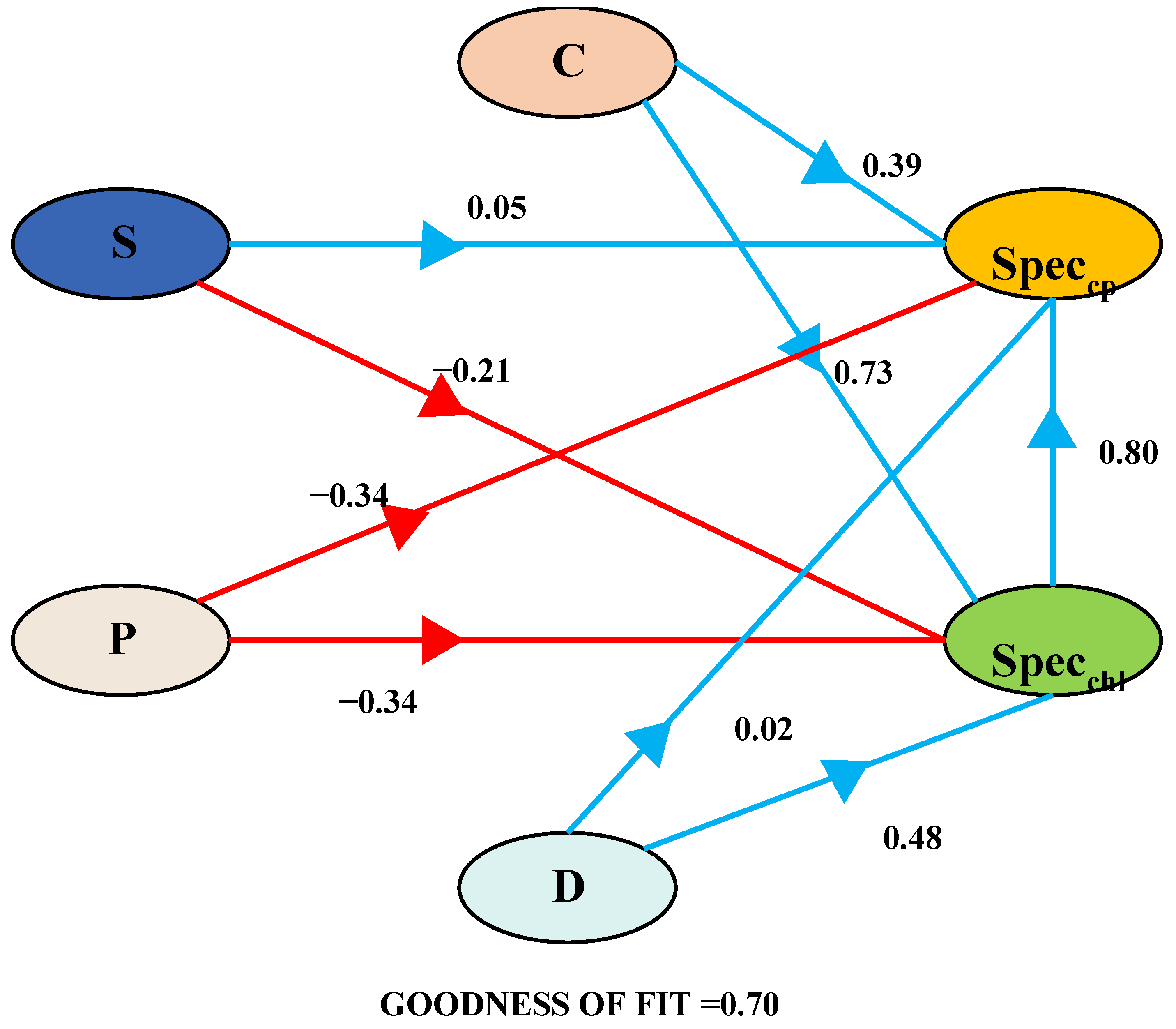
| Degraded Degree | Altitude (m) | Geography Coordinate | Graze Rate (Sheep Unit·Day/hm2) |
|---|---|---|---|
| Non-Degradation (ND) | 2930 | 37.209° N, 102.765° E | 1.06 |
| Light Degradation (LD) | 2960 | 37.204° N, 102.752° E | 3.47 |
| Medium Degradation (MD) | 3080 | 37.233° N, 102.680° E | 6.63 |
| Heavy Degradation (HD) | 2710 | 37.196° N, 102.781° E | 11.02 |
| Over-Degradation (OD) | 2880 | 37.187° N, 102.795° E | 16.64 |
| Plant Species | None Degradation (ND) | Light Degradation (LD) | Medium Degradation (MD) | Heavy Degradation (HD) | Extreme Degradation (OD) | |||||
|---|---|---|---|---|---|---|---|---|---|---|
| Cover | Height | Cover | Height | Cover | Height | Cover | Height | Cover | Height | |
| Poa pratensis | 11.7 | 29.32 | 3.20 | 21.62 | 4.00 | 21.53 | 6.04 | 22.20 | 6.40 | 10.12 |
| Melissitus ruthenicus | 9.32 | 2.31 | 4.12 | 2.42 | 6.52 | 2.34 | 9.32 | 1.82 | 11.23 | 1.23 |
| Kobresia humilis | 26.21 | 15.32 | 17.12 | 10.02 | 9.15 | 7.35 | 4.64 | 5.32 | ||
| Koeleria cristata | 5.32 | 11.31 | 3.65 | 19.40 | 3.33 | 15.70 | 3.22 | 15.60 | ||
| Polygonum viviparum | 0.28 | 7.46 | 16.40 | 24.86 | 18.8 | 10.08 | 17 | 7.56 | ||
| Gentianamacrophylla | 16.21 | 17.24 | 19.12 | 13.02 | 9.23 | 15.21 | ||||
| Potentilla chinensis | 9.32 | 8.23 | 4.25 | 13.03 | 1.12 | 6.02 | ||||
| Stipa purpurea | 5.41 | 16.12 | 4.82 | 19.06 | 3.50 | 15.92 | ||||
| Aster tataricus | 1.32 | 4.41 | 2.78 | 5.80 | 1.42 | 3.80 | ||||
| Carex breviculmis | 22.23 | 8.96 | 9.23 | 7.62 | ||||||
| Allium sikkimense | 2.14 | 3.20 | 1.23 | 2.54 | ||||||
| Iris tenuifolia | 1.32 | 14.56 | 2.56 | 18.32 | 5.23 | 21.02 | ||||
| Polygonum sibiricum | 2.23 | 6.63 | 3.24 | 6.25 | ||||||
| Dracocephalum heterophyllum | 1.23 | 14.23 | 2.32 | 13.25 | ||||||
| Saussurea japonica | 1.63 | 13.16 | 2.54 | 14.22 | ||||||
| Pedicularis kansuensis | 3.24 | 14.23 | 4.02 | 16.23 | ||||||
| Veronica polita | 2.31 | 4.23 | ||||||||
| Leontopodium leontopodioides | 0.45 | 2.12 | 5.14 | 2.25 | ||||||
| Anaphalis lactea | 2.32 | 5.54 | 1.52 | 4.65 | ||||||
| Astragalus membranaceus | 3.36 | 6.32 | 4.32 | 5.32 | ||||||
| Elsholtzia densa | 5.62 | 6.32 | 7.32 | 8.23 | ||||||
| Plantago depressa | 4.32 | 2.23 | 15.2 | 3.14 | ||||||
| Variables | Maximum | Minimum | Mean | SD | CV |
|---|---|---|---|---|---|
| Chl | 3.68 | 1.23 | 2.31 | 0.72 | 0.31 |
| CP | 0.14 | 0.10 | 0.12 | 0.01 | 0.08 |
| Variables | Variables | Formula and Description |
|---|---|---|
| SR [37] | Simple ratio index | R800/R670 |
| mNDVI [38] | Modified red edge normalized difference vegetation index | (R750-R705)/(R750 + R705 + 2R445) |
| NDNI [39] | Normalized difference nitrogen index | log (1/R1510) − log (1/R1680)]/[log (1/R1510) + log (1/R1680) |
| PRI [40] | Photochemical reflectance index | (R531 − R570)/(R531 + R570) |
| SIPI [41] | Structure insensitive pigment index | (R800 − R445)/(R800 − R680) |
| DVI [42] | Difference vegetation index | R810 − R680 |
| NDGI [43] | Normalized difference greenness index | (R750 − R550)/(R750 + R550) |
| NDCI [44] | Normalized difference cloud index | (R762 − R527)/(R762 + R527) |
| SAVI [45] | Soil-adjusted vegetation index | [(1 + 0.5) × (R800 − R670)]/(R800 + R670 + 0.5) |
| RDVI [46] | Renormalized difference vegetation index | (R800 − R670)/(R800 + R670) |
| NRI [47] | Nitrogen reflectance index | (R560 − R670)/(R560 + R670) |
| NDWI [43] | Normalized Difference Water Index | (R857-R1241)/(R857 + R1241) |
| Db [48] | Blue edge amplitude | Maximum first-order differential spectrum at 490–530 nm |
| Λb [48] | Blue edge position | Wavelength position of blue edge amplitude |
| Dy [48] | Yellow edge amplitude | Maximum first-order differential spectrum at 560–640 nm |
| Λy [48] | Yellow edge position | Wavelength position of yellow edge amplitude |
| Dr [48] | Red edge amplitude | Maximum first-order differential spectrum at 680–760 nm |
| Λr [48] | Red edge position | Wavelength position of red edge amplitude |
| Dg [48] | Green peak reflectance | Maximum first-order differential spectrum at 510–560 nm |
| Λg [48] | Location of green peak | Wavelength position of green peak |
| Rr [48] | Red valley reflectance | Minimum first-order differential spectrum at 650–690 nm |
| λRV [48] | Location of red valley | Wavelength position of red valley |
| SDb [48] | Blue edge area | Area surrounded by original spectral curve at 490–530 nm |
| SDr [48] | Red edge area | Area surrounded by original spectral curve at 680–760 nm |
| SDy [48] | Yellow edge area | Area surrounded by original spectral curve at 560–640 nm |
| SDg [48] | Green peak area | Area surrounded by original spectral curve at 510–560 nm |
| Pasture Variables | Model | All Bands | Backward Feature Elimination | |||
|---|---|---|---|---|---|---|
| R2 | RMSE | Selected Bands | R2 | RMSE | ||
| Chl | PLS | PRI, mNDVI | 0.66 | 9.45 | ||
| RF | 0.39 | 0.31 | 359 nm, 652 nm, PRI, SIPI, NDWI, SAVI, NRI, mNDVI, λb, λr | 0.95 | 3.50 | |
| Tree-based | 0.72 | 0.49 | 359 nm, 652 nm, PRI, SIPI, NDWI, SAVI, mNDVI, λr, λb | 0.85 | 6.15 | |
| CP | PLS | 2091 nm, 535 nm, mNDVI, PRI, λr, SAVI | 0.85 | 6.51 | ||
| RF | 0.37 | 0.84 | 359 nm, 535 nm, 2091 nm, PRI, SAVI, λr | 0.94 | 3.72 | |
| Tree-based | 0.31 | 0.10 | 359 nm, 535 nm, 661 nm, 2091 nm, PRI, mNDVI, λr | 0.84 | 6.46 | |
Disclaimer/Publisher’s Note: The statements, opinions and data contained in all publications are solely those of the individual author(s) and contributor(s) and not of MDPI and/or the editor(s). MDPI and/or the editor(s) disclaim responsibility for any injury to people or property resulting from any ideas, methods, instructions or products referred to in the content. |
© 2024 by the authors. Licensee MDPI, Basel, Switzerland. This article is an open access article distributed under the terms and conditions of the Creative Commons Attribution (CC BY) license (https://creativecommons.org/licenses/by/4.0/).
Share and Cite
Ji, T.; Liu, X. Establishing a Hyperspectral Model for the Chlorophyll and Crude Protein Content in Alpine Meadows Using a Backward Feature Elimination Method. Agriculture 2024, 14, 757. https://doi.org/10.3390/agriculture14050757
Ji T, Liu X. Establishing a Hyperspectral Model for the Chlorophyll and Crude Protein Content in Alpine Meadows Using a Backward Feature Elimination Method. Agriculture. 2024; 14(5):757. https://doi.org/10.3390/agriculture14050757
Chicago/Turabian StyleJi, Tong, and Xiaoni Liu. 2024. "Establishing a Hyperspectral Model for the Chlorophyll and Crude Protein Content in Alpine Meadows Using a Backward Feature Elimination Method" Agriculture 14, no. 5: 757. https://doi.org/10.3390/agriculture14050757
APA StyleJi, T., & Liu, X. (2024). Establishing a Hyperspectral Model for the Chlorophyll and Crude Protein Content in Alpine Meadows Using a Backward Feature Elimination Method. Agriculture, 14(5), 757. https://doi.org/10.3390/agriculture14050757






